 |
 |
 |
| |
Efficacy And Safety Of Peginterferon Alfa-2a Versus Adefovir Dipivoxil (ADV) In Treating Lamivudine Resistant HBeAg-Positive CHB: An Interim Analysis Of A Prospective Randomized Study
|
| |
| |
Reported by Jules Levin
AASLD Nov 4 2008 San Francisco, CA
J Hou,1 J Sun,1 Q Xie,2 X Li,3 J Zhang,4 Y Wang,5 H Wang,6 JY Lai,7 S Chen,8 J Jia,9 J-F Sheng,10 H L-Y Chan,11 J Wang,12 M Li,13 M Jiang,14 M Popescu,15 J JY Sung11
1Nanfang Hospital, Guangzhou, China; 2Ruijin Hospital, Shanghai, China; 3You'an Hospital, Beijing, China; 4Huashan Hospital, Shanghai, China; 5Xi'nan Hospital, Changqing, China; 6People's Hospital, Beijing, China; 7Princess Margaret Hospital, Hong Kong, China; 8Infectious Disease Hospital, Shandong, China; 9Friendship Hospital,
Beijing, China; 10The First Affiliated College of Medicine, Zhejiang University, Zhejiang, China; 11Prince of Wales Hospital, Hong Kong, China; 12Public Health Clinical Center Affiliate to Fudan University, Shanghai, China; 13Tuen Mun Hospital, Hong Kong, China; 14Roche, Shanghai, China; 15Roche, Basel, Switzerland
Presented at the 59th Annual Meeting of the American Association for the Study of Liver Diseases, October 31-November 4 2008, San Francisco, USA
AUTHOR SUMMARY
While rates of on-treatment HBV DNA suppression were similar for the peginterferon alfa-2a and adefovir treatment groups, the rates of HBeAg clearance and seroconversion were higher in peginterferon alfa-2a-treated patients
Importantly, HBsAg clearance was seen in a high proportion of patients who had achieved HBeAg seroconversion (42.9%) or HBV DNA <400 copies/mL (14%) during peginterferon alfa-2a therapy
In contrast, no patient treated with adefovir had cleared HBsAg by week 48 HBsAg decline from baseline to week 48 was significantly greater in the peginterferon alfa-2a group compared with adefovir (P<0.001)
The adverse event profile observed in this study was similar to that of previous studies of peginterferon alfa-2a.
Overall, the drug was well tolerated and only ten patients (6.5%) in the peginterferon alfa-2a group discontinued before week 48
CONCLUSION
The encouraging results from this interim analysis of patients previously treated unsuccessfully with lamivudine - a very hard to treat patient population - suggest a role for peginterferon alfa-2a in the management of Chinese patients with YMDD mutations. Importantly, a proportion of patients achieved HBsAg clearance during treatment with peginterferon alfa-2a compared with no adefovir-treated patients. The limited benefit seen with adefovir is similar to that observed in previous small studies of nucleos(t)ide analogs4,5,6
Background
The purely antiviral mode of action of oral antivirals means that they need to be given long term in order to maintain suppression of HBV DNA. Such long-term therapy is associated with development of resistance
Development of resistance to lamivudine reaches approximately 70% following 5 years of uninterrupted treatment and most frequently results from YMDD mutation in the viral polymerase gene1,2,3
Viral resistance can be accompanied by rebound of HBV DNA and ALT levels toward pre-treatment values; in some cases severe ALT flares and rapid decompensation are observed
Antiviral rescue therapy for patients with resistance is limited by the cross-resistance profile of individual nucleos(t)ide analogs4,5,6 (Table 1)
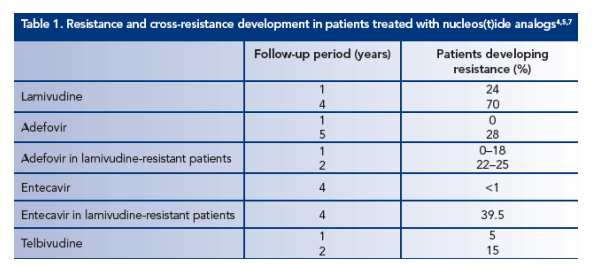
One of the challenges of HBV management is to identify a treatment regimen suitable for patients with YMDD mutations. Data from small studies suggested that a finite course of peginterferon alfa-2a can be effective in achieving a sustained efficacy in patients who failed prior lamivudine therapy.8,9 This could offer patients a viable alternative approach to sequential long-term therapy with another oral antiviral
OBJECTIVE
To compare the efficacy and safety of peginterferon alfa-2a with that of adefovir dipivoxil (adefovir) in HBeAgpositive chronic hepatitis B patients with YMDD mutations
METHODS
This was a randomized, open-label study involving 13 centers across China
Patients with documented lamivudine-resistant (YMDD) HBV were randomized 2:1 to receive peginterferon alfa-2a (180 _g weekly) for 48 weeks or adefovir (10 mg daily) for 72 weeks (Figure 1)
All patients continued lamivudine treatment 100 mg daily for the first 12 weeks
The main efficacy endpoints were: 1) HBeAg seroconversion, 2) HBeAg clearance, 3) HBsAg clearance and 4) HBV DNA <400 copies/mL
In addition, HBsAg levels were quantified at baseline and weeks 24 and 48 using the Architect assay (Abbott Diagnostics)
Efficacy data presented here are from a planned interim per protocol efficacy analysis at week 48 Safety data are based on all patients randomized who received at least one dose of medication
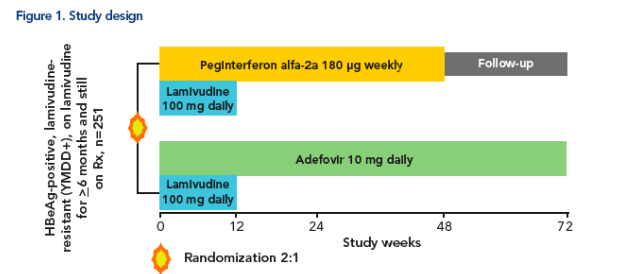
RESULTS
Patient demographic characteristics
A total of 251 patients with documented lamivudine-resistant (YMDD) HBV were randomized 2:1 to receive peginterferon alfa-2a or adefovir dipivoxil. All received at least one dose of study medication and were included in the safety analysis; peginterferon alfa-2a (n=167) and adefovir (n=84)
A total of 235 patients received either peginterferon alfa-2a (n=155) or adefovir (n=80) for 48 weeks and 72 weeks, respectively. Patients reaching the 48-week timepoint were included in the per protocol population for the interim analysis
Baseline characteristics were balanced between the two treatment groups (Table 2)
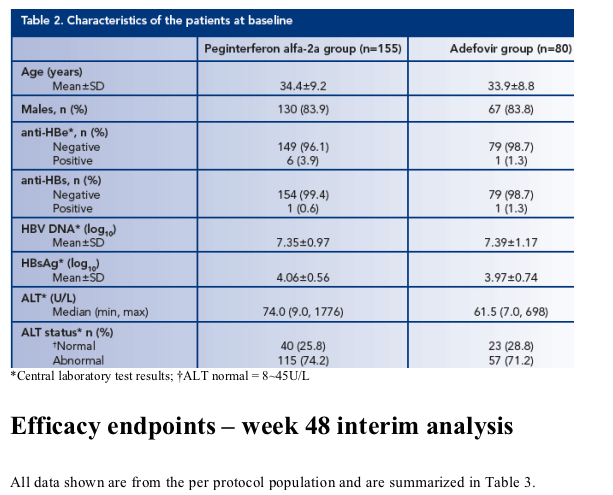

A similar proportion of patients in both groups had HBV DNA levels below 400 copies/mL at week 48 (28.4% for peginterferon alfa-2a-treated patients and 28.8% for adefovir-treated patients, P=NS)
A greater proportion of patients receiving peginterferon alfa-2a achieved HBeAg clearance than adefovir-treated patients (14.2% versus 5%, respectively, P=0.033)
Six (3.9%) patients in the peginterferon alfa-2a group cleared HBsAg compared with none in the adefovir group
(P=0.098, NS)
-- One of the peginterferon alfa-2a-treated patients seroconverted to anti-HBs
-- All 6 patients who had cleared HBsAg had achieved HBeAg seroconversion
-- The rate of HBsAg clearance among patients with HBeAg seroconversion was 42.9% (6/14) (Figure 2)
-- The rate of HBsAg clearance among patients with HBV DNA <400 copies/mL was 13.6% (6/44)
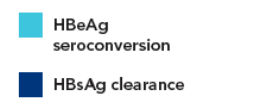
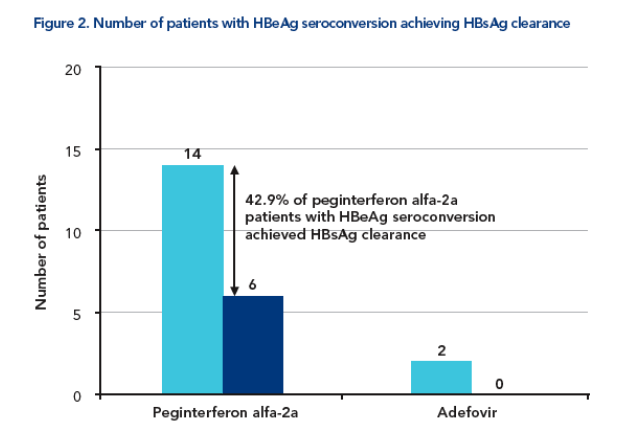
On-treatment HBsAg decline
At baseline the levels of HBsAg were similar between the two treatment groups (Table 4)
Decline of HBsAg from baseline to week 48 was significantly greater in the peginterferon alfa-2a group than that in the adefovir group (P<0.001) (Table 4, Figure 4)
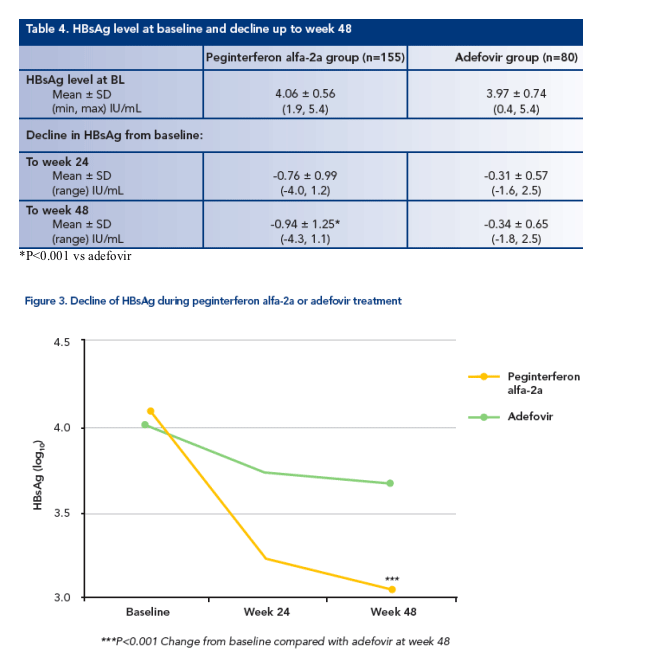
SAFETY
The incidence and profile of adverse events was similar to that reported in other peginterferon alfa-2a studies and overall peginterferon alfa-2a was well tolerated10,11
Most commonly reported events were pyrexia (49.7%), fatigue (18.6%), alopecia (15.6%), headache (13.8%) and myalgia (12.0%)
Severe adverse events were experienced by 4.2% of peginterferon alfa-2a-treated patients and 2.4% of adefovir-treated patients
Ten patients (6.5%) in the peginterferon alfa-2a group discontinued therapy before week 48: three due to adverse events/intercurrent illness, three for violation of selection criteria at entry and four due to an abnormal laboratory test. One patient in the adefovir group failed to return for follow up and one patient refused treatment or withdrew consent
REFERENCES
1. Liaw YF. The current management of HBV drug resistance. J Clin Virol. 2005;34 (Suppl 1):S143-6
2. Liaw YF. Impact of YMDD mutations during lamivudine therapy in patients with chronic hepatitis B. Antivir Chem Chemother 2001;21 (Suppl 1):67-71
3. Kwon SY et al. Rapid re-emergence of YMDD mutation of hepatitis B virus with hepatic decompensation after lamivudine retreatment. World J Gastroenterol 2008;14:4416-9
4. Tenney DJ et al. Two-year assessment of entecavir resistance in lamivudine-refractory hepatitis B virus patients reveals different clinical outcomes depending on the resistance substitutions present. Antimicrob Agents, Chemother 2007;51:902-11
5. Colonno RJ et al. Assessment at three years shows high barrier to resistance is maintained in entecavir-treated nucleoside na´ve patients while resistance emergence increases over time in lamivudine refractory patients [abstract]. Hepatology 2006;44(Suppl 1):229A-230A
6. Lee YS et al. Increased risk of adefovir resistance in patients with lamivudine-resistant chronic hepatitis B after 48 weeks of adefovir dipivoxil monotherapy. Hepatology 2006;43:1385-91
7. Gane E et al. Lack of influence of baseline genotype on antiviral response in subjects with chronic hepatitis B infection receiving tenofovir of 300 mg QD for 1 year. J Hepatol 2008;48:S256-S257
8. Shi XF et al. Peginterferon alfa-2a for patients with HBeAg-positive CHB who failed prior lamivudine treatment. Hepatol Intl 2007;1:(O-90)18
9. Xu D-Z et al. Efficacy and safety of peginterferon alfa-2a in Chinese patients with HBeAg-positive chronic hepatitis B. J Hepatol 2008;48(Suppl 2):(712)S266
10. Lau GK et al. Peginterferon alfa-2a, lamivudine, and the combination for HbeAg-positive chronic hepatitis B. New Engl J Med 2005;2682-95
11. Marcellin P et al. Peginterferon alfa-2a alone, lamivudine, and the two in combination in patients with HBeAgnegative-chronic hepatitis B. N Engl J Med 2004;351:1206-17
DISCLOSURE INFORMATION
Editorial support for the development of this poster was funded by F. Hoffmann-La Roche Ltd, Basel, Switzerland
|
| |
|
 |
 |
|
|